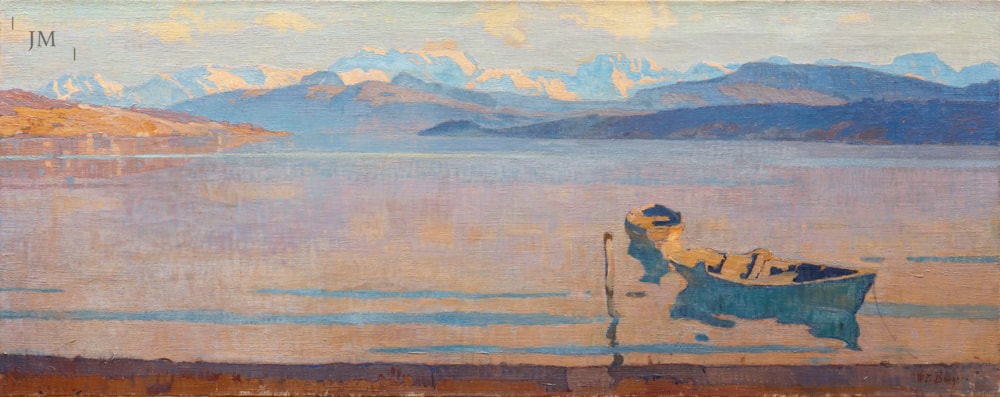Wilhelm Friedrich Burger ( 1882 - 1964 )
Lake Zürich at Rüschlikon, Switzerland

Lake Zürich at Rüschlikon, Switzerland
oil on canvas
23¼ x 59in (59 x 150cm)
signed, circa 1920
item sold
Although Burger cannot be categorized as a Symbolist in the strictest sense, his palette, his penchant for jagged outlines and his ethereal skies owe much to Ferdinand Hodler, the leading Swiss painter of the late nineteenth century. Hovering between Realism and Symbolism in style, this late afternoon view over the Zürichsee from the edge of the lake at Rüschlikon is an overt homage to Hodler who painted nearly 150 pictures of the Swiss lakes, many of them in a similar, panoramic format. Burger went so far as to sign his picture with a more spidery signature than usual – a pastiche of Hodler’s.
Wilhelm, or Willy, Burger is nowadays widely recognized as one of the leading graphic artists of his time. His lithograph posters such as, Jungfraubahn. Station Jungfrau: Joch 3457m. Aletschgletscher, 1914 and St. Moritz, 1912 are far better known – and more costly – than his oil paintings. However, he was first and foremost a painter by training who apprenticed in Zurich before leaving for Philadelphia and New York in 1908. He returned to Switzerland in 1913 where he set up a studio in Rüschlikon on the west shore of Lake Zürich from where he would travel throughout the Alps, the Mediterranean and as far afield as Egypt for his commissions.
In Lake Zürich at Rüschlikon, Burger’s violet and lavender-coloured palette and his handling of the spectacular Glarus Alps is pure Hodler. The way he treated the small boats at anchor by the side of the lake and the shadows on the mountains thrown up by the setting sun is particularly compelling. Looking from left to right, Glärnisch, Hausstock, Pfannenstock and Tödi form the backdrop to Lake Zürich and are often visible on clear days.
From 1901 onwards, Hodler began to concentrate on a series of acclaimed visions of Lac Léman (Geneva) in which he delineated horizontal bands of differing colours and tone. As he developed the theme of receding lines across the lake, or ‘parallelism’, as he called it, Mont Blanc and its surrounding peaks were introduced into the background. Hodler died in 1918 but in these late paintings he sought to express his concept of unité – the idea that there was a fundamental order to the universe and the artist’s role was to reveal it.
Given the critical success of these Lake Geneva paintings, it would suggest that Burger painted Lake Zürich at Rüschlikon around 1920.

